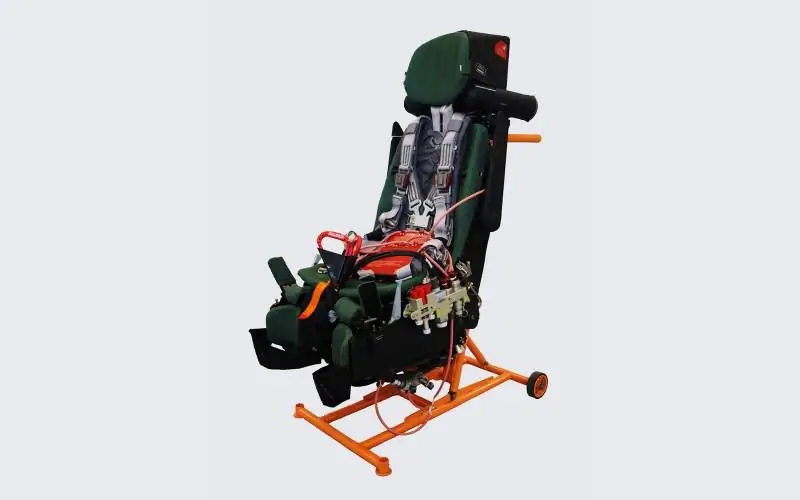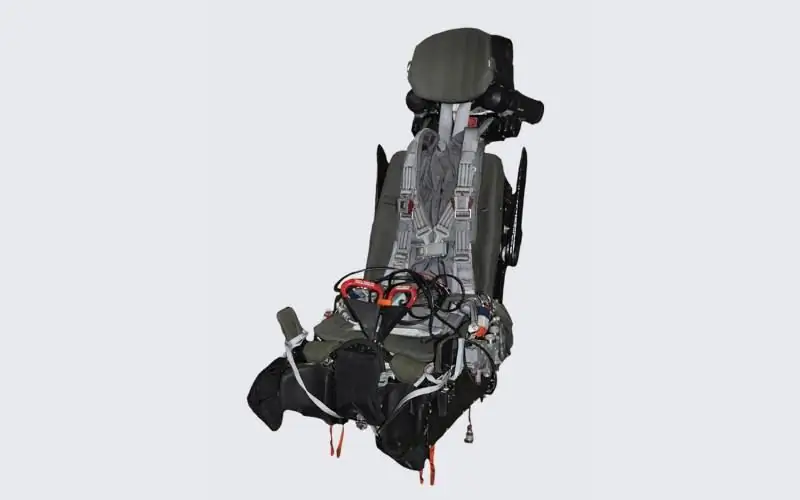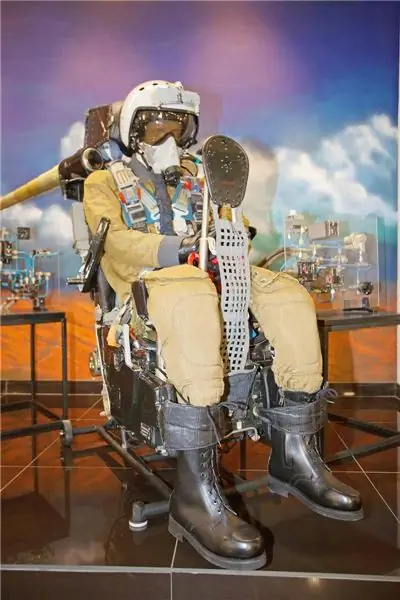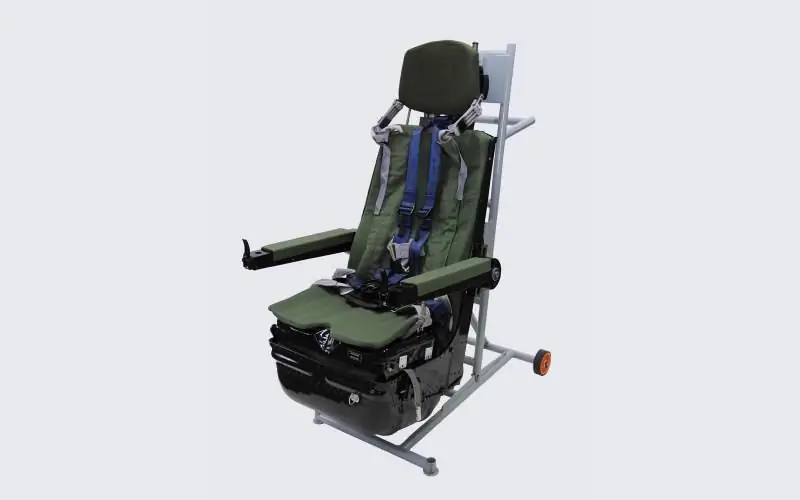- Author Matthew Elmers [email protected].
- Public 2023-12-16 21:49.
- Last modified 2025-01-24 09:17.
October 1952. In the village of Tomilino near Moscow, an experimental plant No. 918 is being organized to create means of ensuring the safety of crews and increasing the survivability of combat aircraft. The decision was not made by chance - the massive transition of aviation to jet thrust and the natural increase in speeds and altitudes left little chance of salvation for the pilots in emergency situations. In those days, it was clear that at a speed of more than 400 km / h, a pilot would under no circumstances be able to independently leave the plane without colliding with structural elements. The space race with the United States also imposed special obligations on Plant # 918, among which were:
- development of experimental high-altitude spacesuits and anti-overload suits for the aircraft crew;
- design of systems for leaving aircraft, ejection seats and special equipment to protect a person after leaving the cockpit;
- research in the field of fire safety of aircraft.
Interestingly, the plant was "settled" in a building that previously produced furniture and skis, and the design headquarters was generally sent to a cold basement room - the post-war state of the Soviet Union made itself felt. In the engineering direction of ejection, the work was carried out in order to ensure a safe flight path of the seat with the pilot relative to the aircraft and to protect against injury from aerodynamic flow. For this, multi-tube firing mechanisms and systems for fixing the legs, pulling the shoulders, as well as limiting the spread of the arms were developed. The first-born were the K-1, K-3 and K-22 chairs, which ensure safe ejection from a height of at least 100 m and speeds up to 1000 km / h. They were actively installed on their machines by the OKB S. A. Lavochkin, V. M. Myasishchev and A. N. Tupolev. The firms of A. M. Mikoyan, A. S. Yakovlev and P. O. Sukhoi independently built emergency escape systems for their products. However, the problem of rescue in the take-off and landing modes remained, the solution of which was the K-24 chair, in which a number of new solutions appeared. So, in addition, a rocket engine was installed, which launches the pilot far from the ground, and a three-dome parachute system, consisting of a stabilizing, braking and main canopy. This was actually the end of the history of the first generation rescue systems, which resulted in about 30 different chairs from different developers. By the 60s, this whole motley company demanded specific skills from the pilots, and the operating personnel suffered from "headaches" associated with the operation and repair. And so in 1965, the Ministry of Aviation Industry issued a decree, according to which Plant No. 918 began to create a unified ejection seat for installation on all aircraft of all aviation firms of the Soviet country. The main requirement was to ensure safe exit from the cab over the entire range of heights, speeds and M numbers, including at zero values of speed and altitude - the so-called "0-0" mode. For those times, this was not an easy task - for this they developed an energy ejection sensor with an increased impulse and a parachute with a forced entry system at speeds up to 650 km / h with simultaneous separation of the pilot from the seat. Rigid telescopic rods with rotating parachutes mounted at the ends provided vertical stabilization, which made it possible to more fully realize the impulse of the rocket engine. All this, coupled with a protective deflector and a set of measures to restrict the pilot's mobility, made it possible to leave the emergency car in a protective helmet at speeds up to 1300 km / h, and when using a pressure helmet up to 1400 km / h. In general, the maximum parameters, according to the chief designer of "Zvezda" Sergei Pozdnyakov, at which it was possible to eject - an altitude of up to 25 km and a speed of up to 3 M values! Here are the names of the brave testers who tested the new technology in all possible modes - V. I. Danilovich, A. K. Khomutov, V. M. Soloviev and M. M. Bessonov. The seats were named K-36 and existed in three versions: K-36D - for high-speed aircraft, K-36L without a deflector - for aircraft with speeds up to 1100 km / h and the unique K-36V - for vertical takeoff and landing aircraft with an automatic (!) leaving the cockpit. In the latter case, the bailout was carried out directly through the glazing of the lantern - there was sometimes no time to shoot it under the conditions of the rapid development of an emergency in the vertical mode of maneuvering on machines of the Yak family.
There was a page in the history of NPP Zvezda for an “exchange of experience” with American colleagues (naturally, in the 90s), during which the K-36D-3, 5A chair was developed, modified to fit US requirements for accommodating flight personnel of a wide anthropometric row. At the Holloman base in the United States, six ejections were carried out at various angles of attack, slides, speeds and roll. By 1998, American experts unanimously recognized Zvezda as the world leader in the development of life support and emergency rescue systems for pilots. Who knows what the results of that "exchange of experience" were in the design of the US16E ejection seat for the F-35 fighter?

Ejection seat K-36D-3, 5. Source: zvezda-npp.ru
Of the novelties related to the Russian period, it is worth noting the K-36D-3, 5 chair from 1994, which received a system that changes the ballistic characteristics of the firing mechanism and rocket engine, depending on the flight mode and the pilot's weight. Modification 3, 5 allows you to leave the emergency vehicle in an inverted position and at extreme dive angles - the control system simply turns off the rocket booster at such moments. Such chairs are installed on the MiG-29, Su-27 and Su-30 of all variants, the Su-34 and Su-35, and the modification with the memorable code K-36L-3, 5YA on the combat training Yak-130. The export model K-36D-3, 5E is supplied to India, Vietnam and Algeria, the K-36D-3, 5M variant can be found in the cockpits of the MiG-29M and the shipborne versions of the MiG29K / KUB. The developments on the "thirty-sixth" theme became the basis for the K-36RB space chair, which makes it possible for the crew to leave the Energia-Buran system. The main goal is to eject during an accident at the start, the ascending part of the flight trajectory, as well as when the shuttle is landing. The difficulty was the need not only to quickly evacuate the crew, but also to take people to a distance of 400-500 meters from the rocket, as well as to be able to bypass the tower on the launch pad of the cosmodrome when ejecting at the start. Another model from Zvezda's engineers, the K-93, has a simplified design and is designed for maximum aircraft speeds of no more than 950 km / h. The main theme of our time at NPP Zvezda is the Su-57 with its K-36D-5 ejection seat, PPK-7 anti-overload suit, VKK-17 altitude-compensating suit and ZSh-10 protective helmet. The new seat is 20% lighter than its predecessor, it is equipped with a backrest and seat heating, and is also capable of operating autonomously in the event of a complete failure of all onboard warning systems of the aircraft. The output of the autonomous power supply unit to the "combat" mode is reduced to 0.3 seconds, and the new powder charges are designed for the entire service life of the aircraft and are able to withstand the temperature range from -60 to +72 degrees.

Ejection seat K-36D-5. Source: zvezda-npp.ru

Dummy in the chair K-36D-5. Source: popmech.ru
Since 1972, NPP Zvezda has been dealing with, at first glance, the paradoxical theme of developing systems for ejection of the crew of helicopters. The basic scheme of emergency escape from the helicopter cockpit was to launch pilots upward using a towing rocket engine with preliminary shooting of the carrying blades. As you know, the first was the Ka-50 with the K-37-800 rocket and parachute system, which provides ejection in the range from 0 to 4000 meters at speeds up to 350 km / h. For the two-seater Ka-52, the letter "M" was added to the seat index.

Cushioning chair "Pamir". Source: zvezda-npp.ru
The Mi-28 lacks such luxury, so it has a light version in the form of the Pamir shock-absorbing chair, which reduces shock loads in the head-pelvis vector in an accident from 50 units to 15-18 units. "Pamir" can also help with frontal and side impact - the pilot's head fixation system will reduce the overloads to 9-20 units. The requirements of aviation rules and airworthiness standards initiated the development of the AK-2000 shock-absorbing seat, used on the Ka-62, Mi-38 and Ka-226 rotorcraft, at NPP Zvezda.
The activities of OAO NPP Zvezda named after academician G. I. Severin are not limited only to ejection seats - the company has in-flight refueling systems according to the “hose-cone” scheme, unique equipment for cosmonauts, oxygen systems and protective equipment for pilots, as well as various parachute systems. But these are the themes of separate stories.






